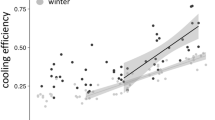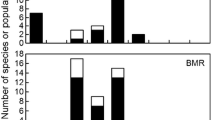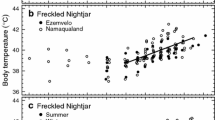Abstract
We evaluated biotic and abiotic predictors of rest-phase hypothermia in wintering blue tits (Cyanistes caeruleus) and also assessed how food availability influences nightly thermoregulation. On any given night, captive blue tits (with unrestricted access to food) remained largely homeothermic, whereas free-ranging birds decreased their body temperature (T b) by about 5°C. This was not an effect of increased stress in the aviary as we found no difference in circulating corticosterone between groups. Nocturnal T b in free-ranging birds varied with ambient temperature, date and time. Conversely, T b in captive birds could not be explained by climatic or temporal factors, but differed slightly between the sexes. We argue that the degree of hypothermia is controlled predominantly by birds’ ability to obtain sufficient energy reserves during the day. However, environmental factors became increasingly important for thermoregulation when resources were limited. Moreover, as birds did not enter hypothermia in captivity when food was abundant, we suggest that this strategy has associated costs and hence is avoided whenever resource levels permit.





Similar content being viewed by others
References
Astheimer LB, Buttemer WA, Wingfield JC (1992) Interactions of corticosterone with feeding, activity and metabolism in passerine birds. Ornis Scand 23:355–365
Bech C, Nicol SC (1999) Thermoregulation and ventilation in the tawny frogmouth, Podargus strigoides: a low-metabolic avian species. Aust J Zool 47:143–153
Brigham RM, Körtner G, Maddocks TA, Geiser F (2000) Seasonal use of torpor by free-ranging Australian owlet-nightjars (Aegotheles cristatus). Physiol Biochem Zool 73:613–620
Brodin A (2007) Theoretical models of adaptive energy management in small wintering birds. Phil Trans R Soc Lond B Biol Sci 362:1857–1871
Buttemer WA, Nicol SC, Sharman A (2003) Thermoenergetics of pre-moulting and moulting kookaburras (Dacelo novaeguineae): they’re laughing. J Comp Physiol B 173:223–230
Carpenter FL (1974) Torpor in an Andean hummingbird: its ecological significance. Science 183:545–547
Chaplin SB (1976) The physiology of hypothermia in the black-capped chickadee, Parus atricapillus. J Comp Physiol 112:335–344
Clark CW, Dukas R (2000) Winter survival strategies for small birds: managing energy expenditure through hypothermia. Evol Ecol Res 2:473–491
Cooper SJ, Gessaman JA (2005) Nocturnal hypothermia in seasonally acclimatized mountain chickadees and juniper titmice. Condor 107:151–155
Cooper CE, Körtner G, Brigham M, Geiser F (2008) Body temperature and activity patterns of free-living laughing kookaburras: the largest kingfisher is heterothermic. Condor 110:110–115
Cyr NE, Romero M (2008) Fecal glucocorticoid metabolites of experimentally stressed captive and free-living starlings: implications for conservation research. Gen Comp Endocrinol 158:20–28
Cyr NE, Earle K, Tam C, Romero LM (2007) The effect of chronic physiological stress on corticosterone, plasma metabolites and immune responsiveness in European starlings. Gen Comp Endocrinol 154:59–66
Dickens MJ, Earle KA, Romero LM (2009) Initial transference of wild birds to captivity alters stress physiology. Gen Comp Endocrinol 160:76–83
Dolby AS, Temple JG, Williams LE, Dilger EK, Stechler KM, Davis VS (2004) Facultative rest-phase hypothermia in free-ranging white-throated sparrows. Condor 106:386–390
Downs CT, Brown M (2002) Nocturnal heterothermy and torpor in the malachite sunbird (Nectarinia famosa). Auk 119:251–260
Fletcher QE, Fisher RJ, Willis CKR, Brigham RM (2004) Free-ranging common nighthawks use torpor. J Therm Biol 29:9–14
Geiser F, Holloway JC, Körtner G, Maddocks TA, Turbill C, Brigham RM (2000) Do patterns of torpor differ between free-ranging and captive mammals and birds? In: Heldmaier G, Klingenspor M (eds) Life in the cold: eleventh international hibernation symposium. Springer, Berlin, pp 95–102
Grubb TC, Pravosudov VV (1994) Toward a general theory of energy management in wintering birds. J Avian Biol 25:255–260
Haftorn S (1972) Hypothermia of tits in the arctic winter. Ornis Scand 3:153–166
Haftorn S (1992) The diurnal body-weight cycle in titmice Parus spp. Ornis Scand 23:435–443
Körtner G, Brigham RM, Geiser F (2000) Winter torpor in a large bird. Nature 407:318
Körtner G, Brigham RM, Geiser F (2001) Torpor in free-ranging tawny frogmouths (Podargus strigoides). Physiol Biochem Zool 74:789–797
Lane JE, Brigham RM, Swanson DL (2004) Daily torpor in free-ranging whip-poorwills (Caprimulgus vociferus). Physiol Biochem Zool 77:297–304
Laurila M, Hohtola E (2005) The effect of ambient temperature and simulated predation risk on fasting-induced nocturnal hypothermia of pigeons in outdoor conditions. J Therm Biol 30:392–399
Lessells CM, Boag PT (1987) Unrepeatable repeatabilities—a common mistake. Auk 104:116–121
Littell RC, Milliken GA, Stroup WW, Wolfinger RD, Schabenberger O (2006) SAS for mixed models. SAS Institute Inc., Cary
Maddocks TA (2001) The thermal physiology and energetics of Australian birds. Ph.D. thesis, University of New England
Maddocks TA, Geiser F (1997) Energetics, thermoregulation and nocturnal hypothermia in Australian silvereyes. Condor 99:104–112
Maddocks TA, Geiser F (2007) Heterothermy in an Australian passerine, the dusky woodswallow (Artamus cyanopterus). J Ornithol 148:571–577
Mayer L, Lustick S, Battersby B (1982) The importance of cavity roosting and hypothermia to the energy-balance of the winter acclimatized Carolina chickadee. Int J Biometeorol 26:231–238
McKechnie AE, Lovegrove BG (2001a) Heterothermic responses in the speckled mousebird (Colius striatus). J Comp Physiol B 171:507–518
McKechnie AE, Lovegrove BG (2001b) Thermoregulation and the energetic significance of clustering behavior in the white-backed mousebird (Colius colius). Physiol Biochem Zool 74:238–249
McKechnie AE, Lovegrove BG (2002) Avian facultative hypothermic responses: a review. Condor 104:705–724
McKechnie AE, Lovegrove BG (2003) Facultative hypothermic responses in an Afrotropical arid-zone passerine, the red-headed finch (Amadina erythrocephala). J Comp Physiol B 173:339–346
McKechnie AE, Körtner G, Lovegrove BG (2004) Rest-phase thermoregulation in free-ranging white-backed mousebirds. Condor 106:143–149
McKechnie AE, Ashdown RAM, Christian MB, Brigham RM (2007) Torpor in an African caprimulgid, the freckled nightjar Caprimulgus tristigma. J Avian Biol 38:261–266
Merola-Zwartjes M (1998) Metabolic rate, temperature regulation, and the energetic implications of roost nests in the bananaquit (Coereba flaveola). Auk 115:780–786
Merola-Zwartjes M, Ligon JD (2000) Ecological energetics of the Puerto Rican tody: heterothermy, torpor, and intra-island variation. Ecology 81:990–1003
Mzilikazi N, Lovegrove BG (2002) Reproductive activity influences thermoregulation and torpor in pouched mice, Saccostomus campestris. J Comp Physiol B 172:7–16
Pettersson J, Hasselquist D (1985) Fat deposition and migration capacity of robins Erithacus rebecula and goldcrests Regulus regulus at Ottenby, Sweden. Ring Migr 6:66–76
Pravosudov VV, Grubb TC (1997) Energy management in passerine birds during the nonbreeding season. A review. Curr Ornithol 14:189–234
Pravosudov VV, Lucas JR (2000) The costs of being cool: a dynamic model of nocturnal hypothermia by small food-caching birds in winter. J Avian Biol 31:463–472
Prinzinger R, Pressmar A, Schleucher E (1991) Body temperature in birds. Comp Biochem Physiol 99:499–506
Rashotte ME, Pastukhov IF, Poliakov EL, Henderson RP (1998) Vigilance states and body temperature during the circadian cycle in fed and fasted pigeons (Columba livia). Am J Physiol Regul Integr Comp Physiol 275:R1690–R1702
Reinertsen RE (1996) Physiological and ecological aspects of hypothermia. In: Carey C (ed) Avian energetics and nutritional ecology. Chapman & Hall, New York, pp 125–157
Reinertsen RE, Haftorn S (1983) Nocturnal hypothermia and metabolism in the willow tit Parus montanus at 63 degrees N. J Comp Physiol 151:109–118
Reinertsen RE, Haftorn S (1984) The effect of short-time fasting on metabolism and nocturnal hypothermia in the willow tit Parus montanus. J Comp Physiol 154:23–28
Reinertsen RE, Haftorn S (1986) Different metabolic strategies of northern birds for nocturnal survival. J Comp Physiol B 156:655–663
Romero LM, Romero RC (2002) Corticosterone responses in wild birds: the importance of rapid initial sampling. Condor 104:129–135
Ruby NF, Nelson RJ, Licht P, Zucker I (1993) Prolactin and testosterone inhibit torpor in Siberian hamsters. Am J Physiol 264:R123–R128
Schleucher E (1999) Energetics and body temperature regulation in two convergent dove species from extreme habitats. Ornis Fenn 76:199–210
Schleucher E (2001) Heterothermia in pigeons and doves reduces energetic costs. J Therm Biol 26:287–293
Schleucher E (2004) Torpor in birds: taxonomy, energetics, and ecology. Physiol Biochem Zool 77:942–949
Schoech SJ, Ketterson ED, Nolan V (1999) Exogenous testosterone and the adrenocortical response in dark-eyed juncos. Auk 116:64–72
Seber GAF, Lee AJ (2003) Linear regression analysis. Wiley-Interscience, New York
Sharbaugh SM (2001) Seasonal acclimatization to extreme climatic conditions by black-capped chickadees (Poecile atricapilla) in interior Alaska (64 degrees N). Physiol Biochem Zool 74:568–575
Sokal RR, Rohlf FJ (1995) Biometry. W.H. Freeman, New York
Spencer KA, Verhulst S (2008) Post-natal exposure to corticosterone affects standard metabolic rate in the zebra finch (Taeniopygia guttata). Gen Comp Endocrinol 159:250–256
Waite TA (1991) Nocturnal hypothermia in gray jays Perisoreus canadensis wintering in interior Alaska. Ornis Scand 22:107–110
Welton NJ, Houston AI, Ekman J, McNamara JM (2002) A dynamic model of hypothermia as an adaptive response by small birds to winter conditions. Acta Biotheor 50:39–56
Wingfield JC, Farner DS (1975) Determination of 5 steroids in avian plasma by radioimmunoassay and competitive protein binding. Steroids 26:311–327
Woods CP, Brigham RM (2004) The avian enigma–“hibernation” by common poorwills (Phalaenoptilus nuttalli). In: Barnes BM, Carey CM (eds) Life in the cold: evolution, mechanisms, adaptation, and application, Institute of Arctic Biology. University of Alaska, Fairbanks, pp 231–240
Acknowledgments
We are grateful to Charlotta Borell Lövstedt for supplying climatic data from the study area. Comments from Indrikis Krams and three anonymous reviewers improved a previous version of the manuscript. This study was supported by grants from the Swedish Research Council (to J.-Å. N.). All experimental protocols adhere to the guidelines of the Swedish Animal Welfare Agency and were approved by the Malmö/Lund Animal Care Committee, Sweden (permit nos. M53-06, M237-07).
Author information
Authors and Affiliations
Corresponding author
Additional information
Communicated by G. Heldmaier.
Rights and permissions
About this article
Cite this article
Nord, A., Nilsson, J.F., Sandell, M.I. et al. Patterns and dynamics of rest-phase hypothermia in wild and captive blue tits during winter. J Comp Physiol B 179, 737–745 (2009). https://doi.org/10.1007/s00360-009-0357-1
Received:
Revised:
Accepted:
Published:
Issue Date:
DOI: https://doi.org/10.1007/s00360-009-0357-1




